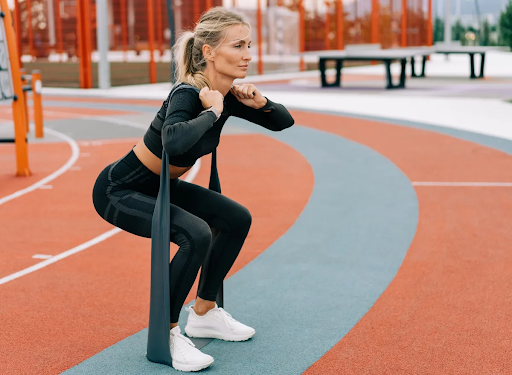
Menu

With the surge in popularity of working out at home, many individuals are discovering the significance of including fitness equipment in their exercise routines. One standout and easily accessible tool is the resistance band. These stretchy bands have become a favorite among fitness enthusiasts of all skill levels because of their versatility. Whether your goal is to tone your muscles, increase strength, or enhance flexibility, resistance bands offer a budget-friendly solution for home workouts. In this article, we will delve into the advantages of incorporating resistance bands into your fitness regimen, explore the types available, and provide impactful workout routines that you can easily integrate into your fitness journey.
Resistance bands provide a range of exercise options, making them great for targeting muscle groups. Whether you want to focus on your arms, legs, or core, these bands can adapt to movements. They work well for upper body workouts like bicep curls and shoulder presses; lower body exercises such as squats and leg lifts; and core strengthening exercises like twists and planks.
No matter your fitness level, resistance bands offer a workout experience. They come in levels of resistance, allowing beginners to gradually increase intensity and challenge advanced fitness enthusiasts. This adaptability makes resistance bands a fitness tool for everyone, from beginners to experienced athletes.
One major advantage of resistance bands is their portability, making them a convenient choice for home workouts. Unlike gym equipment, these bands are lightweight and easy to carry around, enabling you to exercise anywhere. Whether you’re at home or on the go—be it traveling or enjoying the outdoors—resistance bands make it simple to maintain consistency with your fitness routine.
Choosing to invest in a set of resistance bands is a budget option instead of buying costly gym equipment. These bands provide a workout experience without putting a strain on your wallet. With their durability and versatility, resistance bands offer a solution for reaching your fitness goals within the convenience of your home.

Loop bands are bands that are closed and commonly used for a variety of exercises. They offer versatility. Can be utilized for both upper and lower body workouts. Many people prefer loop bands for exercises like squats, lunges, and lateral leg raises.
Tube bands consist of a tube with handles on each end, providing a grip during exercises. These bands work well for targeting muscle groups in the upper body, such as the arms, shoulders, and chest. Common exercises using tube bands include bicep curls, tricep extensions, and chest presses.
Figure eight bands get their name from their shape resembling the number eight. These versatile bands can be used for exercises that target both the upper and lower body muscles effectively. The unique design provides resistance options, making them suitable for a range of workouts.
Fabric bands are flat bands made of material similar to cloth. They prove useful for glute activation exercises while being less prone to rolling or bunching up during use.
Resistance bands made of fabric provide an effective method to increase the difficulty of movements, which is why they are widely used in lower-body workouts.
Mini bands are looped resistance bands that are frequently utilized to target muscle groups. They are commonly employed in exercises such as leg raises, hip abductions, and other movements that emphasize activating the hips and glutes. Mini bands are compact, easy to carry around, and adaptable for workout situations.

When choosing resistance bands, it’s important to take into account your fitness level and goals. These bands generally come in levels of resistance, such as light, medium, and heavy. If you’re a beginner, starting with resistance and gradually increasing it can be a good approach. On the other hand, advanced users may prefer levels of resistance for more challenging workouts.
Make sure to consider the material and overall quality of the resistance bands. High-quality bands are usually made of latex or rubber to ensure durability. Before using them, check for any signs of wear or damage to ensure they last longer. Quality bands are less likely to snap or lose their elasticity over time.
For tube bands, in particular, choose resistance bands that have handles or grips. It’s important that the handles provide a grip during exercises to prevent slipping. Additionally, make sure that the material used is skin-friendly to avoid any discomfort or irritation while working out.
Take into account the length and size of the resistance bands, especially when considering loop bands or figure eight bands. The length determines your range of motion, as well as the variety of exercises you can perform with them comfortably. Choose bands that allow you to maintain form during exercises without experiencing tension or slackness.
1. Warm-up Exercises.
2. Upper Body Exercises.
3. Lower Body Exercises.
4. Core Strengthening Exercises
5. Cool-Down Stretches
Building Strength and Muscle
Improving Flexibility and Mobility
Remember to adjust the resistance level based on your fitness level and gradually increase it as you get stronger. Always prioritize proper form and listen to your body to prevent injury.
Proper warming up and cooling down
Make sure to warm up before starting your resistance band workout. Begin with stretches and light aerobic exercises to get your muscles and joints ready. After your workout, cool down with stretches to increase flexibility and reduce muscle soreness.
Maintaining form and technique
Focus on using the form and technique for each exercise. Keep an eye on your posture, activate the muscles you’re targeting, and move through the range of motion. Using form not only makes the workout more effective but also lowers the risk of getting injured. If you’re unsure about how to do an exercise, consider getting guidance from a fitness expert.
Gradually increase resistance levels
As you get stronger and build endurance, slowly move up to resistance levels. Start with bands. Raise the resistance as you get more comfortable with the exercises. Avoid using resistance that is too challenging. It makes you compromise your form. Increasing resistance ensures a workout that is both challenging and safe.
Listening to Your Body and Avoiding Overtraining
Pay attention to how your body reacts during the workout. If you feel any pain during your workout (not to be confused with the discomfort caused by muscle fatigue), it’s important to stop and check your form. Make sure to give yourself rest between workout sessions and include rest days in your routine to avoid overtraining. Pay attention to what your body’s telling you and adjust the intensity of your workouts as necessary to prevent burnout and injuries.
In conclusion, resistance bands stand out as an accessible and versatile fitness tool with numerous benefits. From enhancing muscle strength to promoting flexibility, these bands offer a cost-effective and convenient solution for effective home workouts. As we recap their versatility in targeting various muscle groups, it’s clear that resistance bands cater to all fitness levels and provide a wide range of exercises. I encourage everyone to consider incorporating resistance bands into their home workout routines, as they offer a practical and enjoyable way to achieve fitness goals. With their portability and adaptability, resistance bands ensure that maintaining a consistent exercise routine is both achievable and enjoyable. As a recommendation, consider exploring the quality resistance bands from Weights And Glory, a brand known for durability and effectiveness in enhancing your fitness journey.